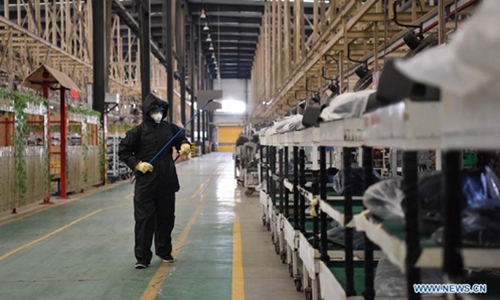HOME >> OPINION
Dual tasks of virus battle, work resumption attest to vitality of China’s system
By Wang Wenwen Source:Global Times Published: 2020/2/25 23:08:41 Last Updated: 2020/2/25 23:28:06

A worker disinfects the factory of Chang'an Automobile in Dingzhou, north China's Hebei Province, February 16, 2020. Companies in Dingzhou resumed production with epidemic prevention measures during the outbreak of the novel coronavirus. (Xinhua/Zhu Xudong)
The nationwide fight against the deadly novel coronavirus is still on, meanwhile various sectors in many parts of the country have resumed work. Some Western media rashly judge that the Chinese economy is not resilient enough to withstand this epidemic, and predict that large-scale resumption of work may risk the renewed spread of the virus.
This tests China's system. On the one hand, lockdown and control measures are still in place in many parts of the country to curb the spread of the virus. On the other, people are gradually returning to their workplaces before the virus is completely contained, and that is why the Chinese leadership is confident in the economy gradually picking up momentum. Observations and correct understanding of China should go beyond the country's virus fight.
The battle against the virus and product resumption can go forward simultaneously for the next few months. There has seen a steep decline in newly reported cases outside the epicenter Hubei Province, compared to the early stage of the outbreak, but it does not mean the government and the public could relax their vigilance. China's economy and people's work and lives cannot be on hold for long. The dual tasks pose a huge challenge to China's governance, but is also a chance to show the vitality of the Chinese system.
The central government has encouraged people to return to work, and urged local governments and companies to adopt flexible approaches. Each province has implemented measures in accordance with their own situation.
In Dongguan, South China's Guangdong Province, a key manufacturing city in the Pearl River Delta, the government requires manufacturers to constantly check if their facilities are sanitized and staff are healthy. In Yiwu, East China's Zhejiang Province, vendors and customers will have their body temperatures tested at the entrances of the wholesale market. Many provinces have set their emergency response levels.
To ensure that the virus control and preventive work and people's resumption of production do not conflict, there needs to be both government tough measures and public awareness.
The government is aware that its policies cannot go without public cooperation, and the public understands that the policies taken by the government are for the good of the people and the country. This positive interaction between the government and the people is exactly where the advantage of China's system lies.
Outside of China, there are over 2,000 infection cases across 28 countries, and these countries will face the same tough test that China has been through. Over the weekend when the number of cases spiked in South Korea, thousands of Christian activists in Seoul defied a government ban on large protests and gathered for their weekly protest against the president, exposing the country and other people to the spread of the virus.
China's measures have started to prove effective, and society is gradually resuming normal life. It is not easy to change the Western media's stereotypical view of China's system. But this time, China's efforts to activate its economy amid an arduous fight against the virus epidemic can hardly be ignored, as the Chinese economy, if stalled, may disrupt industrial production not only in China but throughout the world. Maybe it is time for cynical Westerners to learn about the vitality of China's system.
Posted in: OBSERVER